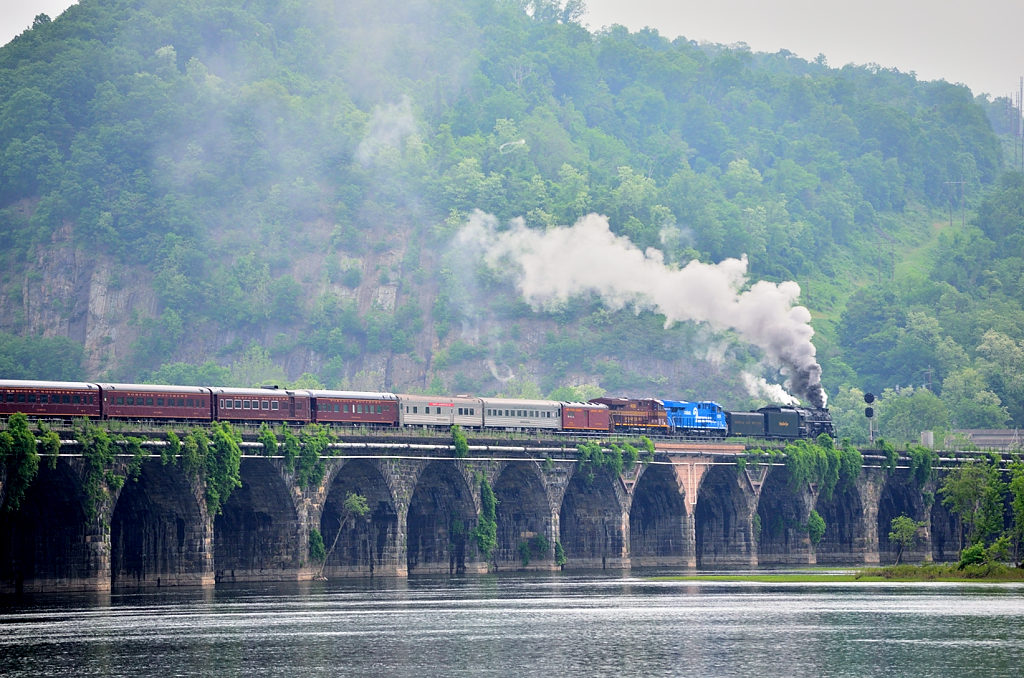Here you will find information and facts relating to the Pittsburgh Line as well as links to various websites and a photo gallery.

The Pittsburgh Line spans 248 miles (399 km) crossing the Allegheny Mountains through the the Gallitzin Tunnels and the Famous Horseshoe Curve in the process. It is the Norfolk Southern Railway’s primary east–west artery in its Pittsburgh Division and Harrisburg Division (Formerly the Pennsylvania Railroad’s (PRR) Middle Division main line) across the state of Pennsylvania. , The Pittsburgh Line is arguably Norfolk Southern’s busiest freight corridor, where 50 to 70 trains traverse the line daily.
DIVISIONS:
- Harrisburg Division PT 105.1 – PT 118.9
- Pittsburgh Division PT 118’9 – PT 353.3
TUNNELS:
The Pittsburgh Line has several tunnels along it’s route. They are as follows:
- Spruce Creek – PT 213.8 – 1,151 ft
- Allegheny – PT 248.3 – 3,612 ft
- Gallitzen – PT 248.3 – 3,612 ft
- New Portage – PT 248.3 – 1,620 ft
HISTORY:
The Pittsburgh Line is a former Pennsylvania Railroad property, beginning as two rail lines, the Middle Division Main Line and the Pittsburgh Division Main Line which were combined to the form the modern day Pittsburgh Line.
LOCOMOTIVE SHOPS:
Juniata Shops in Altoona, Pennsylvania is the site of Norfolk Southern’s largest locomotive repair facility on the NS system. Originally constructed by the Pennsylvania Railroad in 1850 this large complex of shops is what gave the city of Altoona its worth and structure.
PASSENGER SERVICE:
A pair of Amtrak passenger trains travel the Pittsburgh Line. Amtrak’s Pennsylvanian make the following Pennsylvania station stops on the Pittsburgh Line: Harrisburg, Lewistown, Huntingdon, Tyrone, Altoona, Johnstown, Latrobe, Greensburg, and Pittsburgh.
HELPER SERVICE:
Helper locomotives are used by Norfolk Southern on the Pittsburgh Line to assist heavy trains over mountainous portions of the line. Helper crews are mainly based in Altoona and Conemaugh/Johnstown though some helpers are called as far away as Pittsburgh. For many years, EMD SD40-2 locomotives held down pusher duties in the Altoona Helper Pool until 2009 when newer SD40E locomotives constructed by Juniata began to phase out the older locomotive models. The SD40E’s finally filled the ranks of the SD40-2’s in the summer of 2010. Both locomotive models are rated at 3,000 horsepower (2,200 kW), and are either used in pairs or pairings of pairs, the latter are known as “4-Bangers” on the mountain.
THE ALLEGHENIES:
The Pittsburgh Line is a double-track mainline from Duncannon to Altoona. Once at Altoona a third track is added for the climb up the Allegheny Mountains. The line goes back to two at Conpit Junction, where the Conemaugh Line remains a single-track route.
The east slope of the Pittsburgh Lines climb traverses remote mountainous terrain at a grade of about 1.8%. Roughly halfway up the westward ascent lies the engineering marvel of Horseshoe Curve. Originally constructed by the Pennsylvania Railroad in 1854 the 220-degree curve was the solution for the railroad to gain enough elevation around a valley to reach the higher land across to continue west. Constructed mainly by immigrants, the curve was built by cutting into the hillside around Kittanning Point and filling in the necessary places for the railroad right-of-way to be laid.
Past the curve the Pittsburgh Line continues west to Gallitzin passing through MG Interlocking a mile west of Horseshoe Curve. East of Gallitzin the railroad passes through Bennington Curve, Past Bennington Curve at a railroad timetable station called “SF” the three tracks split. Tracks 2 (bi-directional) and 3 (westward) continue on towards Gallitzin at their same ascent, while Track 1 (eastward) diverges up a 2.46% grade known as “The Slide” which is a downhill-only track restricting trains to traveling no more than 12 miles per hour (19 km/h) over its steep grade. Both sets of main tracks pass through tunnels to exit and crest in the town of Gallitzin. Tracks 2 and 3 pass through the new Allegheny Tunnel, while Track 1 passes through the New Portage Tunnel. A third tunnel can be seen the Gallitzin Tunnel, which used to house Track 3 before the Allegheny Tunnel was heightened and widened to house Tracks 2 and 3 as well as doublestack container traffic on intermodal trains in 1994. Upon its completion in 1995 the Gallitzin Tunnel was officially closed.
Past Gallitzin the railroad passes through the small town of Cresson where all of the Pittsburgh Line’s tracks come back together. Here is also where a locomotive helper base is located as well as interchange with the RJ Corman Railroad.
Past Cresson the railroad passes down the Alleghenies’ west slope and through the towns of Lilly, Cassandra, Portage, Wilmore, Summerhill, South Fork, Mineral Point, Parkhill, and East Conemaugh before reaching Johnstown at the bottom of the mountain. South Fork is the junction of the South Fork Secondary a coal route used to reach local mines in the area which generates a train or two a day bound for various destinations.
TERMINALS:
The Pittsburgh Line is marked with three major freight terminals on both of its ends.
- Harrisburg
- Enola
- Conway
DISASTERS:
Bennington Curve was the site of a Pennsylvania Railroad passenger wreck in 1947 killing 16 people and injuring over 100.
LINKS:
PHOTOS:



